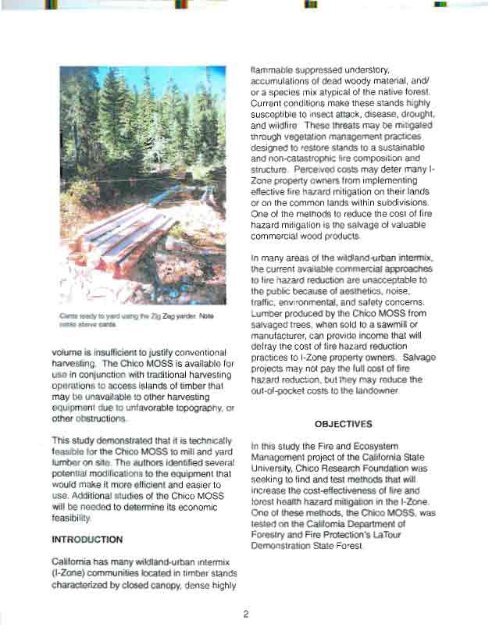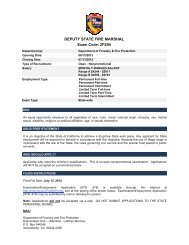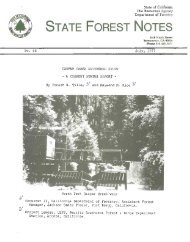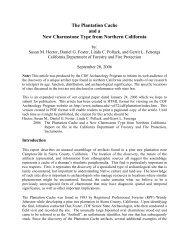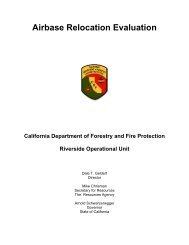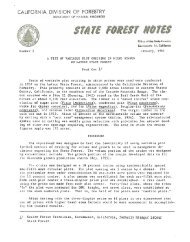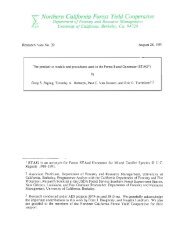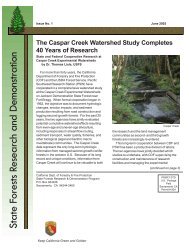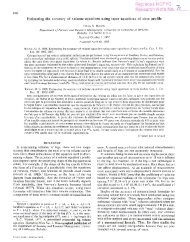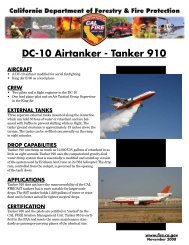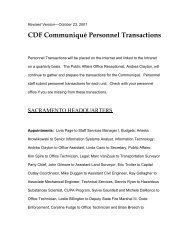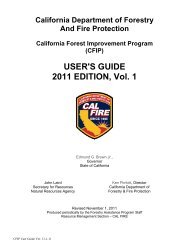CALIFORNIA FORESTRY NOTE - Demoforests.net
CALIFORNIA FORESTRY NOTE - Demoforests.net
CALIFORNIA FORESTRY NOTE - Demoforests.net
You also want an ePaper? Increase the reach of your titles
YUMPU automatically turns print PDFs into web optimized ePapers that Google loves.
~<br />
. . -<br />
..<br />
i<br />
\ ~A ~> ,..4'<br />
\.' ;. .~><br />
f' ..'. ", ;1'. " ~~.. 'il<br />
J - l~-'(-:<br />
Cants ready to yard using the Zig Zag yarder. Note<br />
cable above cants.<br />
volume is insufficient to justify conventional<br />
harvesting. The Chico MOSS is available for<br />
use in conjunction with traditional harvesting<br />
operations to access islands of timber that<br />
may be unavailable to other harvesting<br />
equipment due to unfavorable topography, or<br />
other obstructions.<br />
. This study demonstrated that it is technically<br />
feasible for the Chico MOSS to mill and yard<br />
lumber on site. The authors identified several<br />
potential modifications to the equipment that<br />
would make it more efficient and easier to<br />
use. Additional studies of the Chico MOSS<br />
will be needed to determine its economic<br />
feasibility.<br />
INTRODUCTION<br />
California has many wildland-urban intermix<br />
(I-Zone) communities located in timber stands<br />
characterized by closed canopy, dense highly<br />
2<br />
flammable suppressed understory,<br />
accumulations of dead woody material, and/<br />
or a species mix atypical of the native forest.<br />
Current conditions make these stands highly<br />
susceptible to insect attack, disease, drought,<br />
and wildfire. These threats may be mitigated<br />
through vegetation management practices<br />
designed to restore stands to a sustainable<br />
and non-catastrophic fire composition and<br />
structure. Perceived costs may deter many 1-<br />
Zone property owners from implementing<br />
effective fire hazard mitigation on their lands<br />
or on the common lands within subdivisions.<br />
One of the methods to reduce the cost of fire<br />
hazard mitigation is the salvage of valuable<br />
commercial wood products.<br />
In many areas of the wildland-urban intermix,<br />
the current available commercial approaches<br />
to fire hazard reduction are unacceptable to<br />
the public because of aesthetics, noise,<br />
traffic, environmental, and safety concerns.<br />
Lumber produced by the Chico MOSS from<br />
salvaged trees, when sold to a sawmill or<br />
manufacturer, can provide income that will<br />
defray the cost of fire hazard reduction<br />
practices to I-Zone property owners. Salvage<br />
projects may not pay the full cost of fire<br />
hazard reduction, but they may reduce the<br />
out-of-pocket costs to the landowner.<br />
OBJECTIVES<br />
In this study the Fire and Ecosystem<br />
Management project of the California State<br />
University, Chico Research Foundation was<br />
seeking to find and test methods that will<br />
increase the cost-effectiveness of fire and<br />
forest health hazard mitigation in the I-Zone.<br />
One of these methods, the Chico MOSS, was<br />
tested on the California Department of<br />
Forestry and Fire Protection's LaTour<br />
Demonstration State Forest.


